

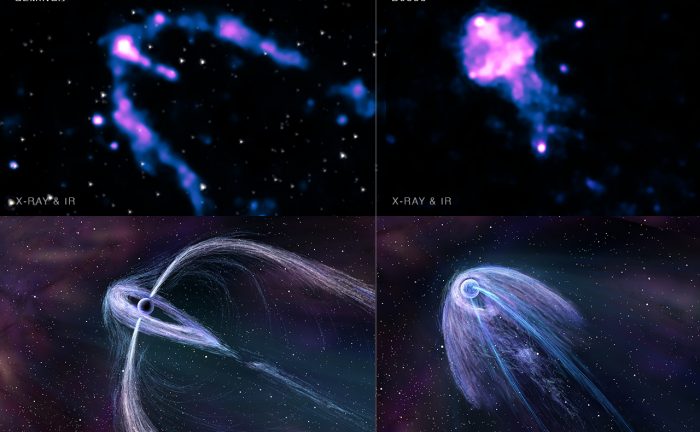
Four-panel graphic showing the two pulsars, Geminga (upper left) and B0355+54 (upper right), observed by Chandra. Credit: NASA/JPL-Caltech/CXC/PSU/B.Posselt et al/N.Klingler et al/Nahks TrEhnl
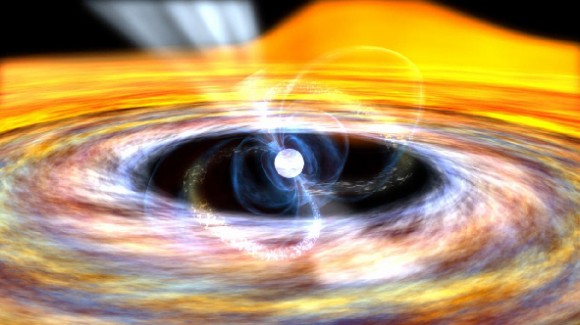
Published on May 14, 2013 Pulsars are thought to emit relatively narrow radio beams, shown as green in this animation. If these beams don't sweep toward Earth, astronomers cannot detect the radio signals. Pulsar gamma-ray emission (magenta) is thought to form a broader fan of radiation that can be detected even when the radio beam is unfavorably oriented. (No audio.) Credit: NASA/Fermi/Cruz deWilde Category Science & Technology License Standard YouTube License
An artist’s impression of an accreting X-ray millisecond pulsar. Credit: NASA/Goddard Space Flight Center/Dana Berry
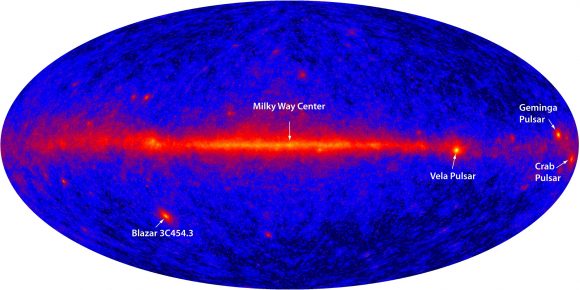
An all-sky view from the Fermi Gamma-ray Space Telescope, showing the position of Geminga in the Milky Way. Credit : NASA/DOE/International LAT Team.
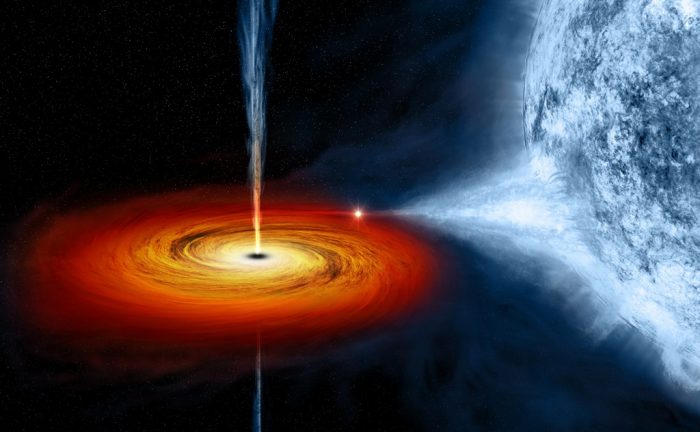
An artist's impression of a pulsar syphoning material away from a companion star, leading to the formation of a millisecond pulsar.
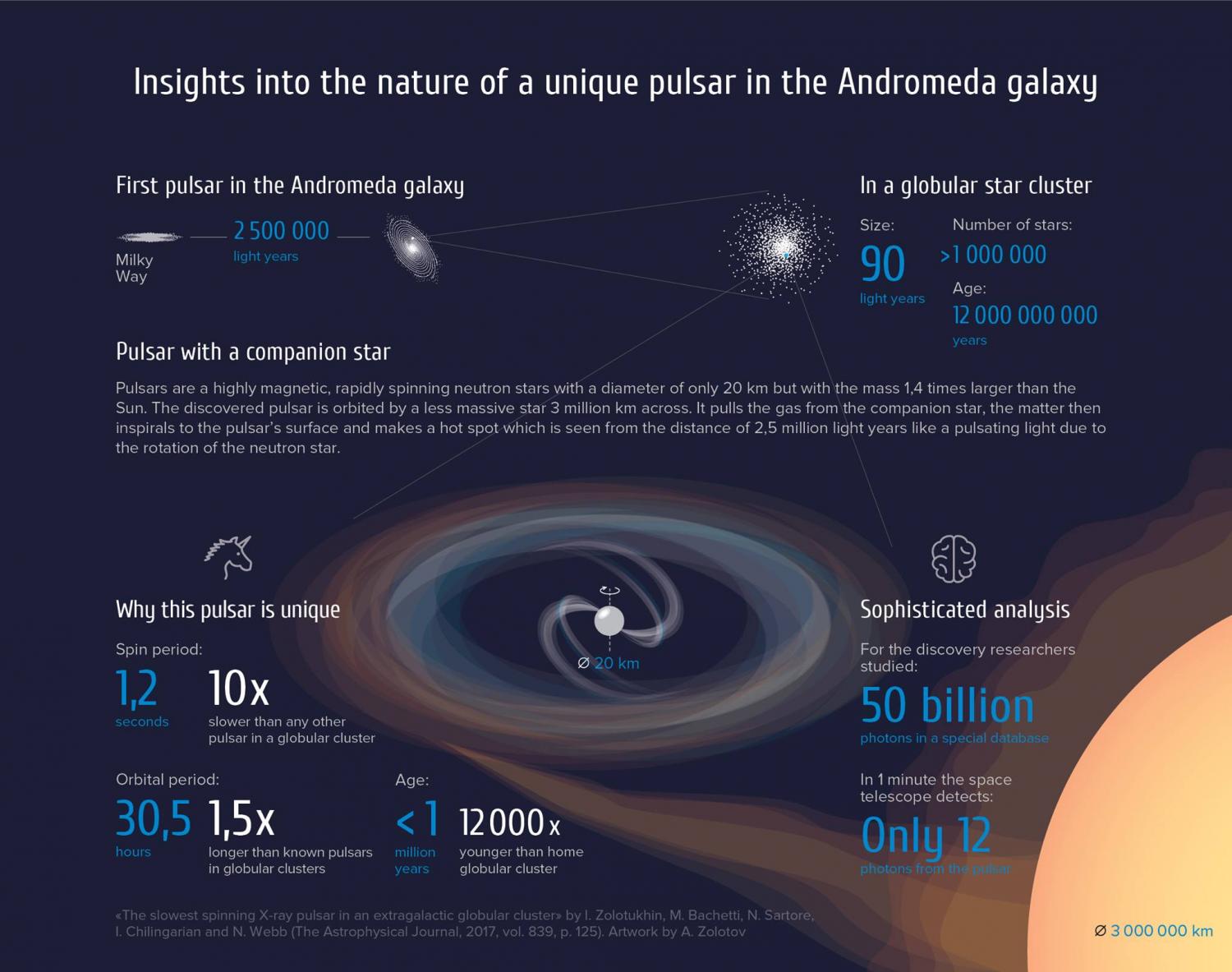
The slowest spinning X-ray pulsar in a globular star cluster has been discovered in the Andromeda galaxy. Credit: A. Zolotov
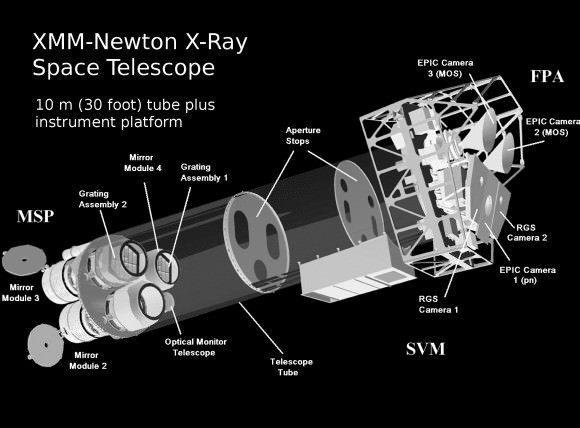
A diagram of the ESA XMM-Newton X-Ray Telescope. Delivered to orbit by a Ariane 5 launch vehicle in 1999. Credit: ESA/XMM-Newton
From THE
Published on Sep 25, 2013 This animation illustrates how an old pulsar in a binary system can be reactivated -- and sped up to a millisecond spin -- by accreting gas from its companion star. A pulsar is a rapidly rotating neutron star that emits pulses of radiation (such as X-rays and radio waves) at regular intervals. A millisecond pulsar is one with a rotational period between 1 and 10 milliseconds, or from 60,000 to 6,000 revolutions per minute. Pulsars form in supernova explosions, but even newborn pulsars don't spin at millisecond speeds, and they gradually slow down with age. If, however, a pulsar is a member of a binary system with a normal star, gas transferred from the companion can spin up an old, slow pulsar to the millisecond range. For more information, go to This video is public domain and can be downloaded at: Category Science & Technology License Standard YouTube License
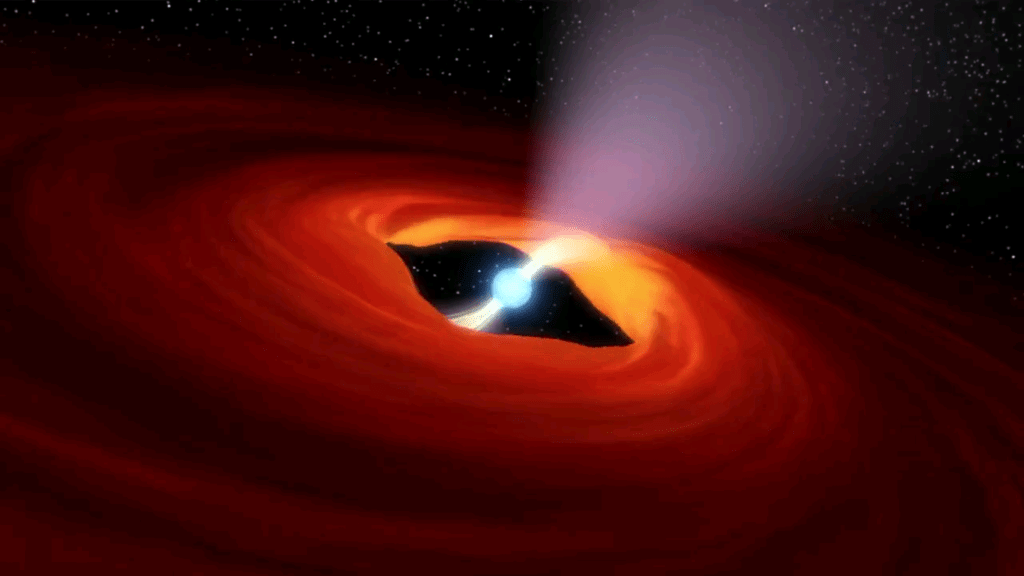
Artist's illustration of a rotating neutron star, the remnants of a super nova explosion. Credit: NASA, Caltech-JPL
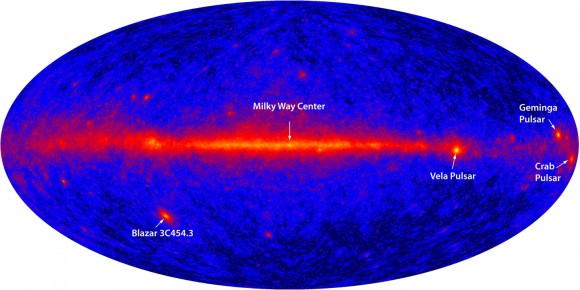
An all-sky view in gamma ray light made with the Fermi gamma ray space telescope. Credit: NASA/DOE/International LAT Team

Artist’s impression of a pulsar siphoning material from a companion star. Credit: NASA
This animation shows a black widow pulsar like J0952 together with its small stellar companion, as seen from within their orbital plane. Powerful radiation and the pulsar's "wind" — an outflow of high-energy particles — strongly heat the facing side of the companion, evaporating it over time. Credit: NASA's Goddard Space Flight Center/Cruz deWilde This video is public domain and may be downloaded at: Related story: Category Science & Technology License Standard YouTube License
Black widow spiders and their Australian cousins, known as redbacks, are notorious for an unsettling tendency to kill and devour their male partners. Astronomers have noted similar behavior among two rare breeds of binary system that contain rapidly spinning neutron stars, also known as pulsars. The essential features of black widow and redback binaries are that they place a normal but very low-mass star in close proximity to a millisecond pulsar, which has disastrous consequences for the star. Black widow systems contain stars that are both physically smaller and of much lower mass than those found in redbacks. So far, astronomers have found at least 18 black widows and nine redbacks within the Milky Way, and additional members of each class have been discovered within the dense globular star clusters that orbit our galaxy. One black widow system, named PSR J1311-3430 and discovered in 2012, sets the record for the tightest orbit of its class and contains one of the heaviest neutron stars known. The pulsar's featherweight companion, which is only a dozen or so times the mass of Jupiter and just 60 percent of its size, completes an orbit every 93 minutes -- less time than it takes to watch most movies. The side of the star facing the pulsar is heated to more than 21,000 degrees Fahrenheit (nearly 12,000 C), or more than twice as hot as the sun's surface. Recent studies allow a range of values extending down to 2 solar masses for the pulsar, making it one of the most massive neutron stars known. Watch the video to learn more about this system and its discovery from some of the scientists involved. :This video is public domain and can be downloaded at Like our videos? Subscribe to NASA's Goddard Shorts HD podcast: Or find NASA Goddard Space Flight Center on Facebook: Or find us on Twitter: Category Science & Technology License Standard YouTube License
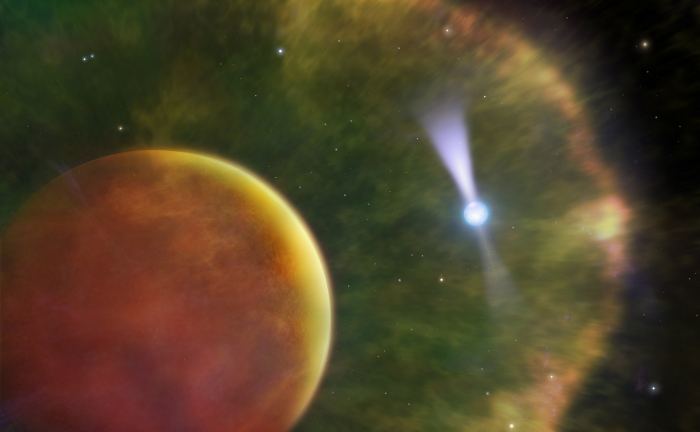
Artist’s impression of the pulsar PSR B1957+20 (seen in the background) through the cloud of gas enveloping its brown dwarf star companion. Credit: Dr. Mark A. Garlick; Dunlap Institute for Astronomy & Astrophysics, University of Toronto
This question comes from William. He writes "Hi Fraser, I was wondering if you could do a video on pulsars like you did on quasars." You got it. Stars are held in perfect balance between the pressure of gravity pulling them inward, and the outward force of radiation. Once stars runs out of fuel, they collapses in on themselves - it's the amount of mass decides what happens next. The most massive stars detonate as supernovae, and can explode or collapse into black holes. If they're less massive, like our Sun, they blast away their outer layers and then slowly cool down as white dwarfs. But for stars between 1.4 and 3.2 times the mass of the Sun, they may still become supernovae, but they just don't have enough mass to make a black hole. These medium mass objects end their lives as neutron stars, and some of these can become pulsars or magnetars. Gravity overwhelms the atomic bonds of the matter in a neutron star, crushing protons and electrons together into neutrons. This is how they get their name. A star that used to be more than a million kilometers wide is now less than 20 kilometers across. This material is so dense, that a single sugar cube's worth weigh about 100 million tonnes on Earth. And you would need to be traveling 100,000 km/s to escape a neutron star's pull - about 1/3rd the speed of light. So that's how you get a neutron star. But what about these pulsars? When these stars collapse, they maintain their angular momentum. But with a much smaller size, their rotational speed increases dramatically, spinning many times a second. This relatively tiny, super dense object, emits a powerful blast of radiation along its magnetic field lines. Although this beam of radiation doesn't necessarily line up with it's axis of rotation. And so, from here on Earth, astronomers detect an intense beam of radio emissions several times a second, as it rotates around like a lighthouse beam. This is a pulsar. The first one was detected in 1967 by Jocelyn Bell Burnell and Antony Hewis. They detected a mysterious radio emission coming from a fixed point in the sky that peaked every 1.33 seconds. Although they were certain it had a natural origin, they named it LGM-1, which stands for "little green men", and subsequent discoveries have helped astronomers discover the true nature of these strange objects. Pulsars have been discovered emitting many different wavelengths of light, from radio to visible and even X and gamma rays. There have been a total of 1600 found so far, and the fastest discovered emits 716 pulses a second. When a pulsar first forms, it has the most energy and fastest rotational speed. As it releases electromagnetic power through its beams, it gradually slows down. Within 10 to 100 million years, it slows to the point that its beams shut off and the pulsar becomes quiet. When they are active, they spin with such uncanny regularity that they're used as timers by astronomers. Pulsars help us search for gravitational waves, probe the interstellar medium, and even find extrasolar planets in orbit. It has even been proposed that spacecraft could use them as beacons to help navigate around the Solar System. On NASA's Voyager spacecraft, there are maps that show the direction of the Sun to 14 pulsars in our region. If aliens wanted to find our home planet, they couldn't ask for a more accurate map. I hope that helps, William.
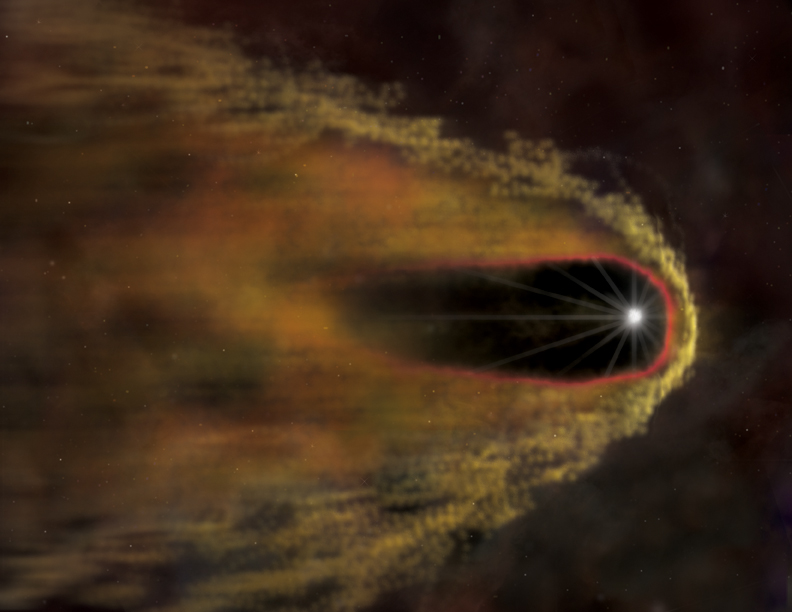
Image of the pulsar surrounded by its bow shock. White rays indicate particles of matter and antimatter being spewed from the star. Its companion star is too close to the pulsar to be visible at this scale. Credit: NASA/CXC/M.Weiss
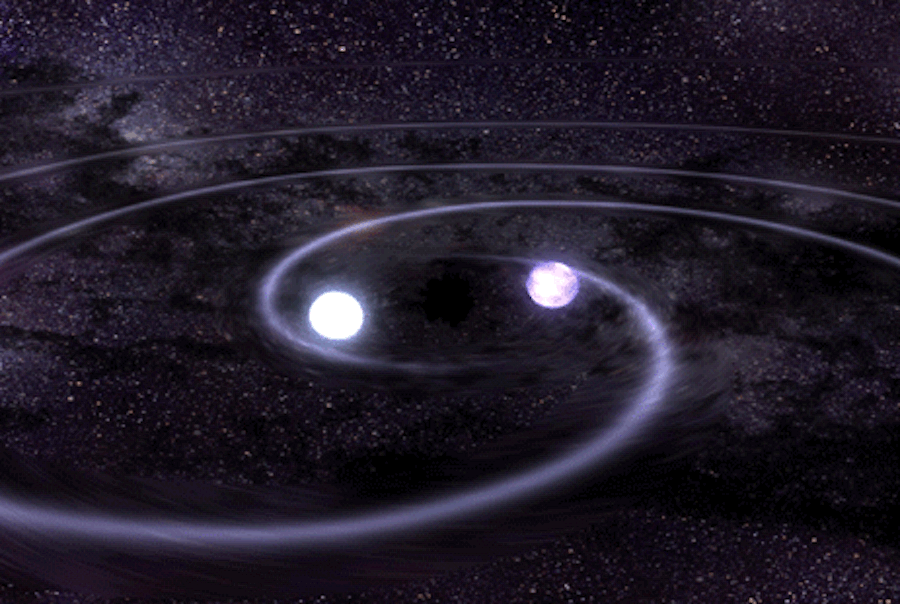
Artist impression of a binary white dwarf system similar to J1634+44 (Credit : Dana Berry)
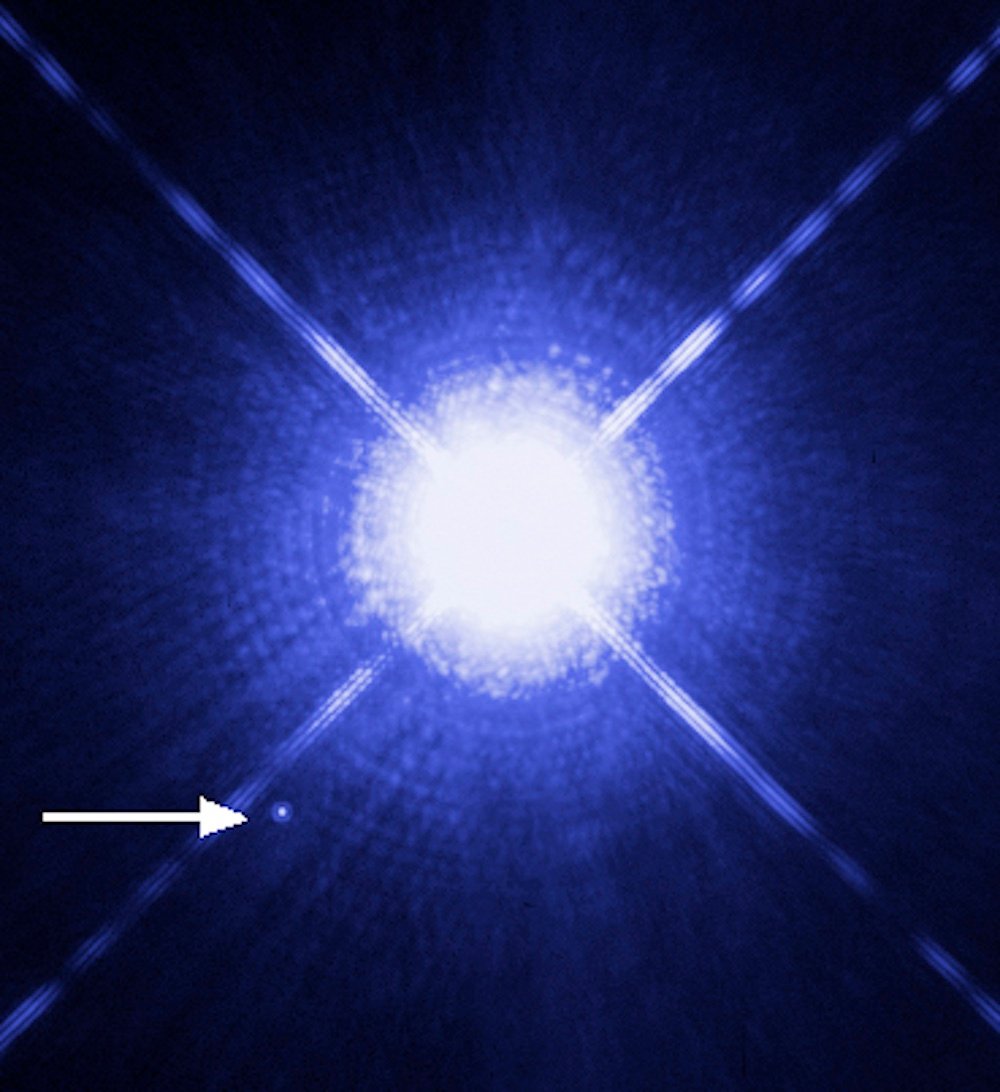
Image of the Sirius system taken by the Hubble Space Telescope. Sirius B, which is the closest white dwarf to Earth, can be seen as a faint point of light to the lower left of the much brighter Sirius A. (Credit : NASA/ESA)

The LOFAR 'superterp'. This is part of the core of the extended telescope located near Exloo, Netherlands (Credit : LOFAR / ASTRON)